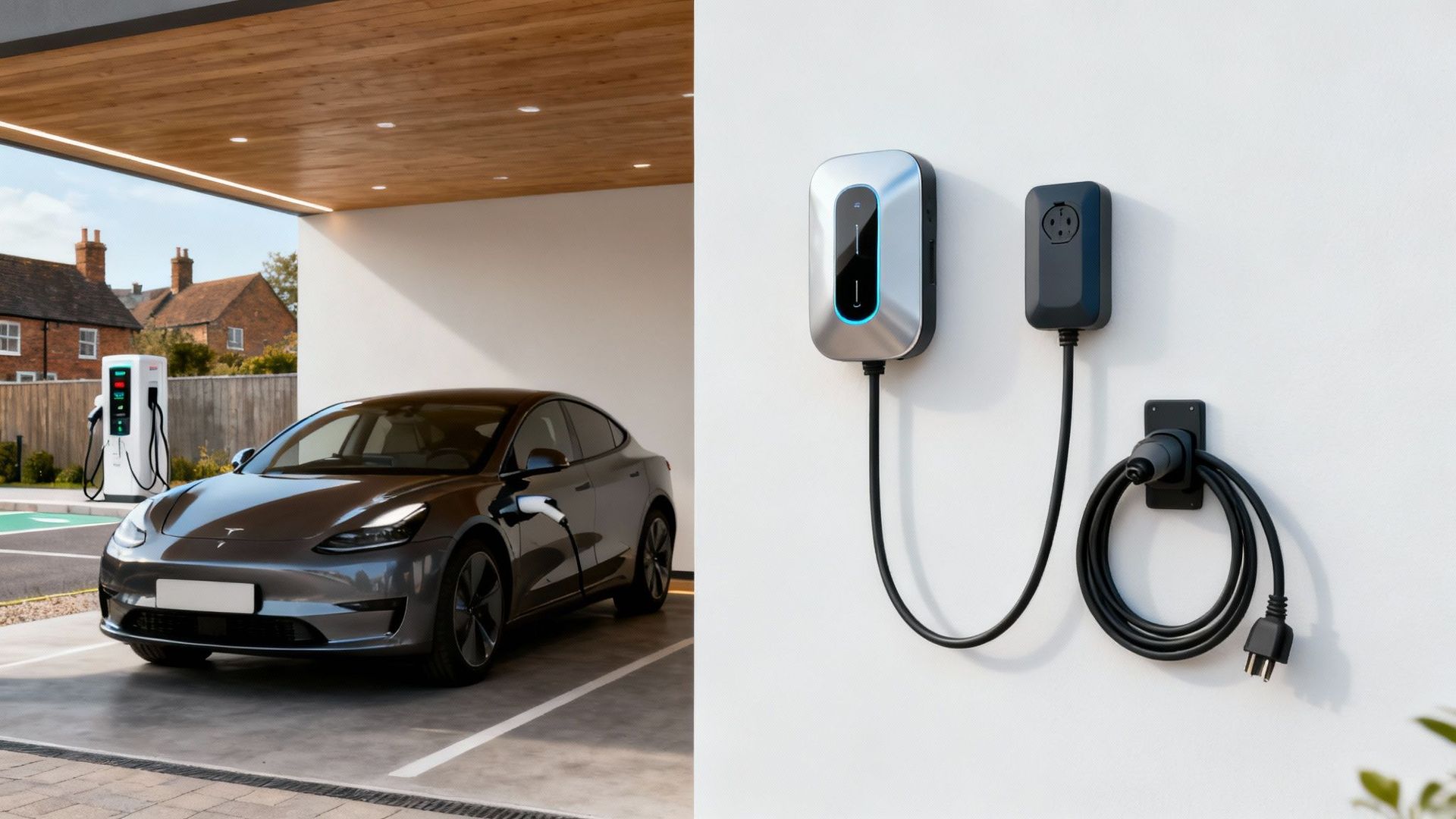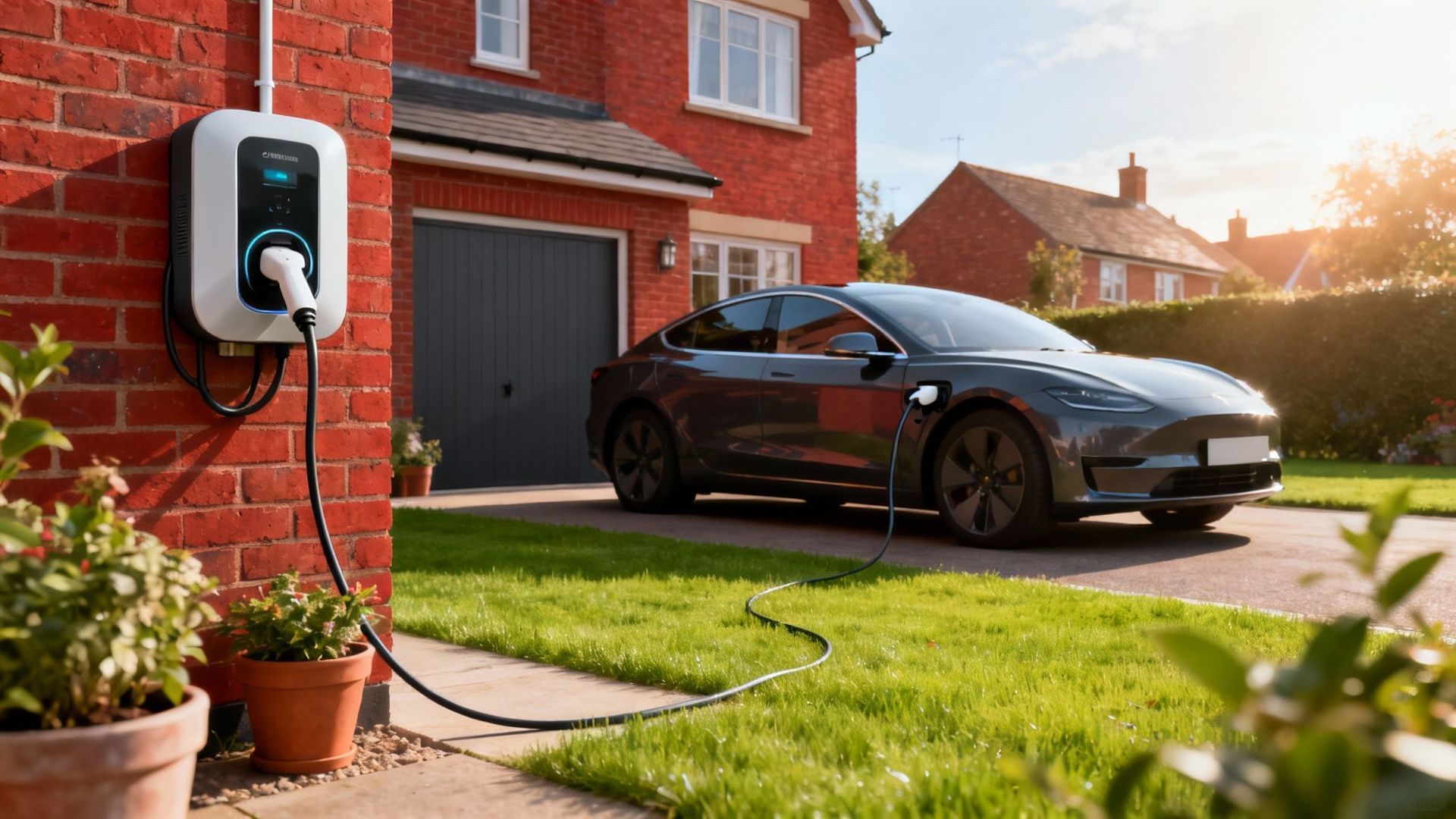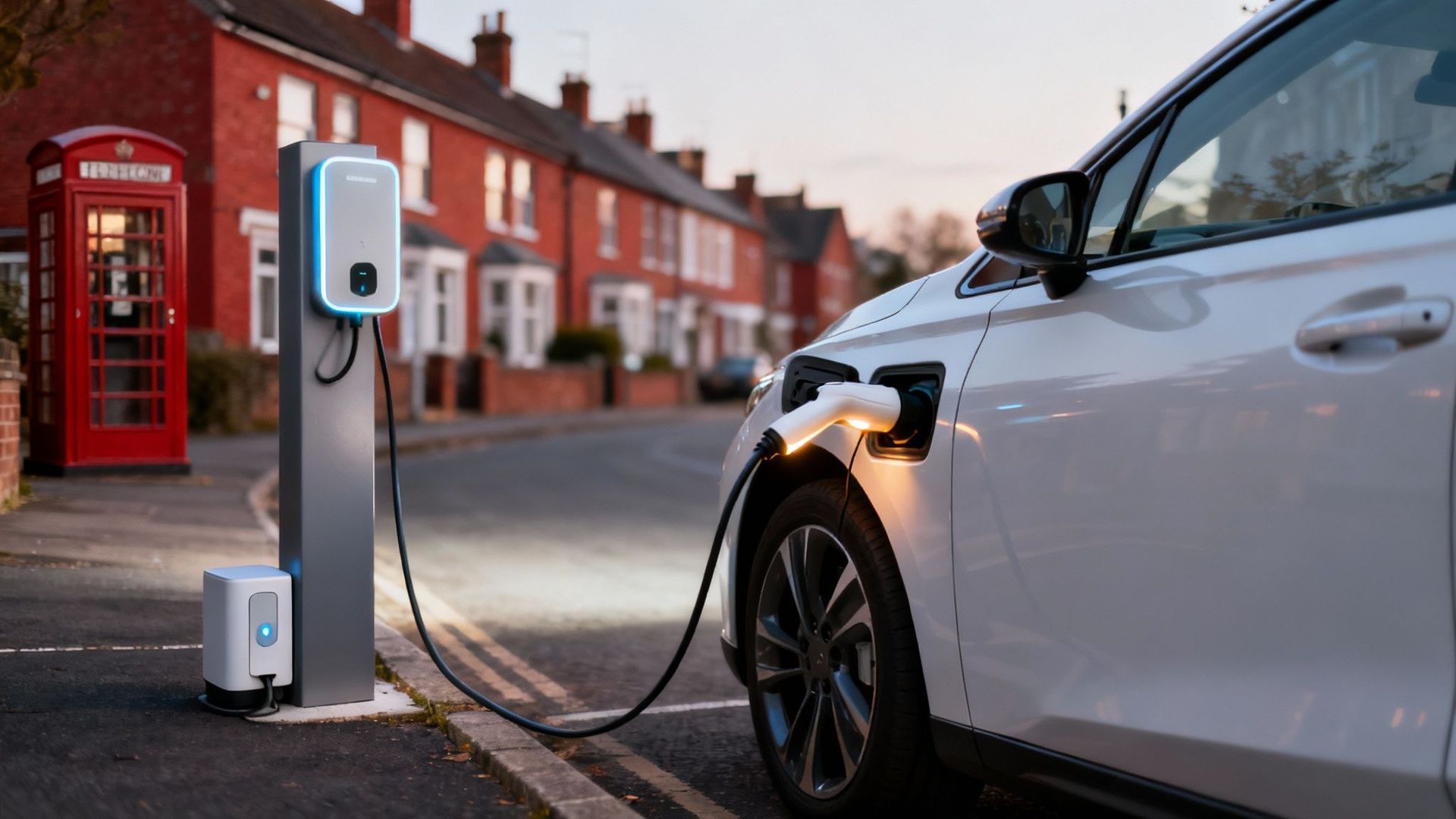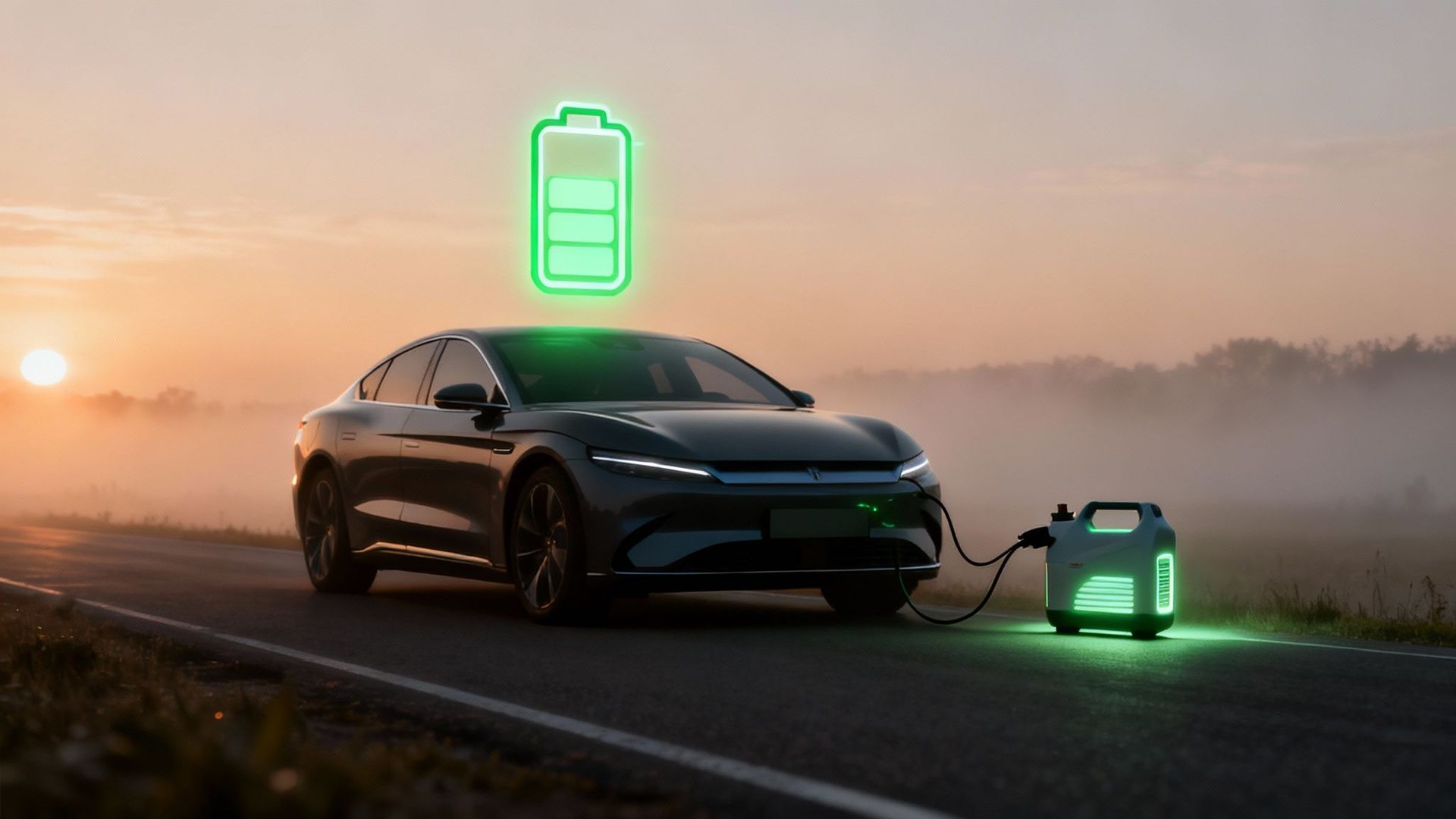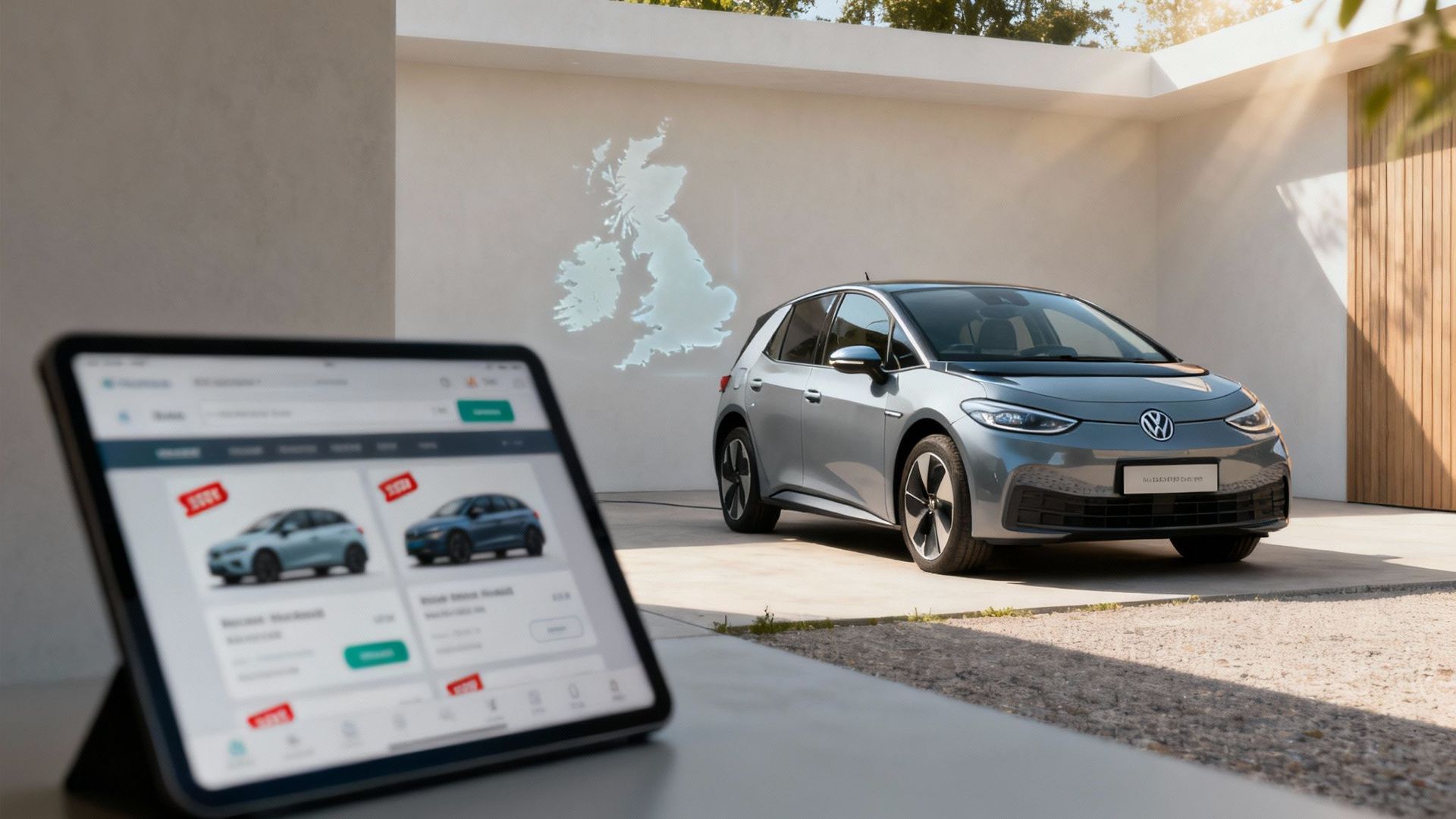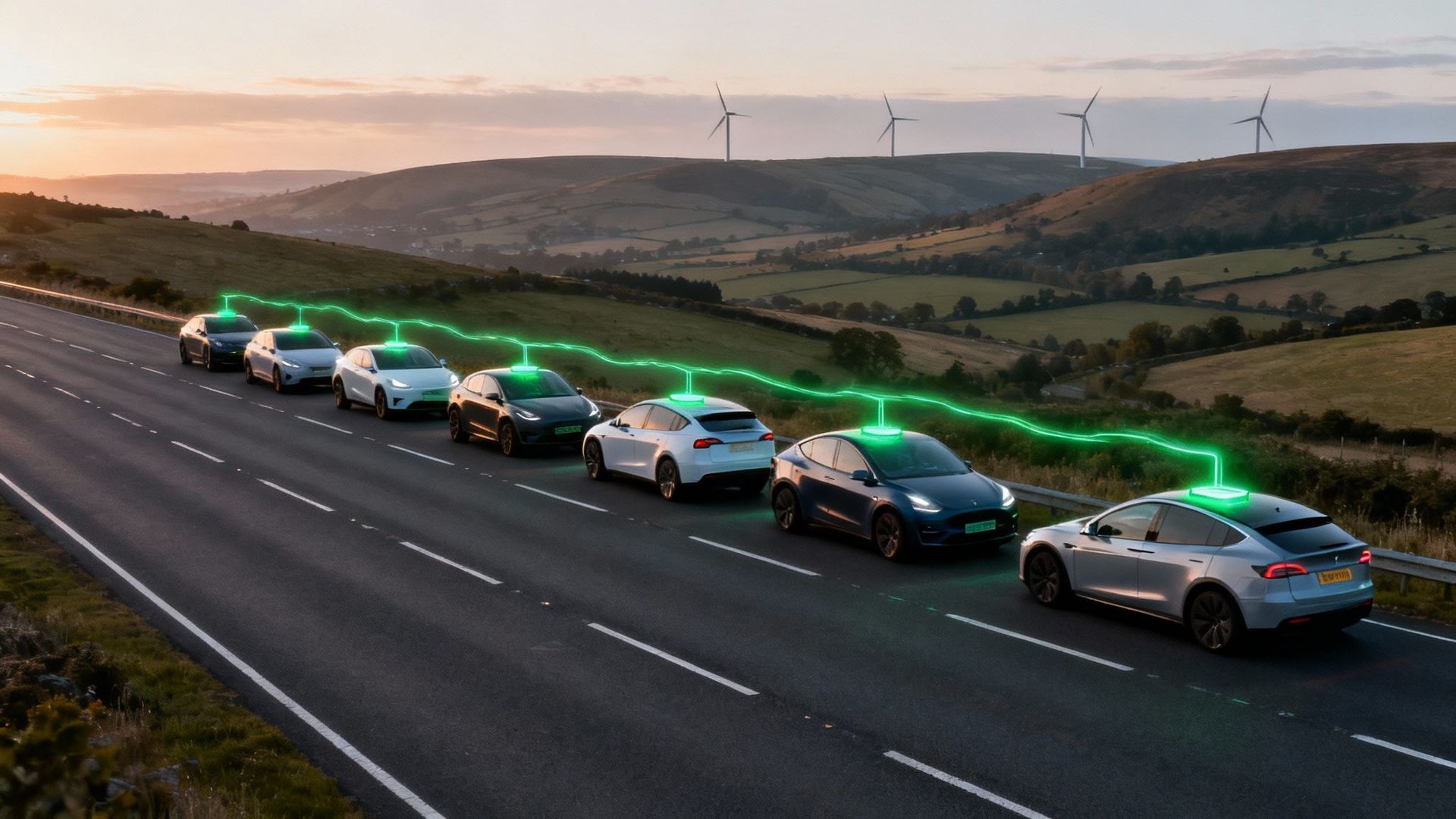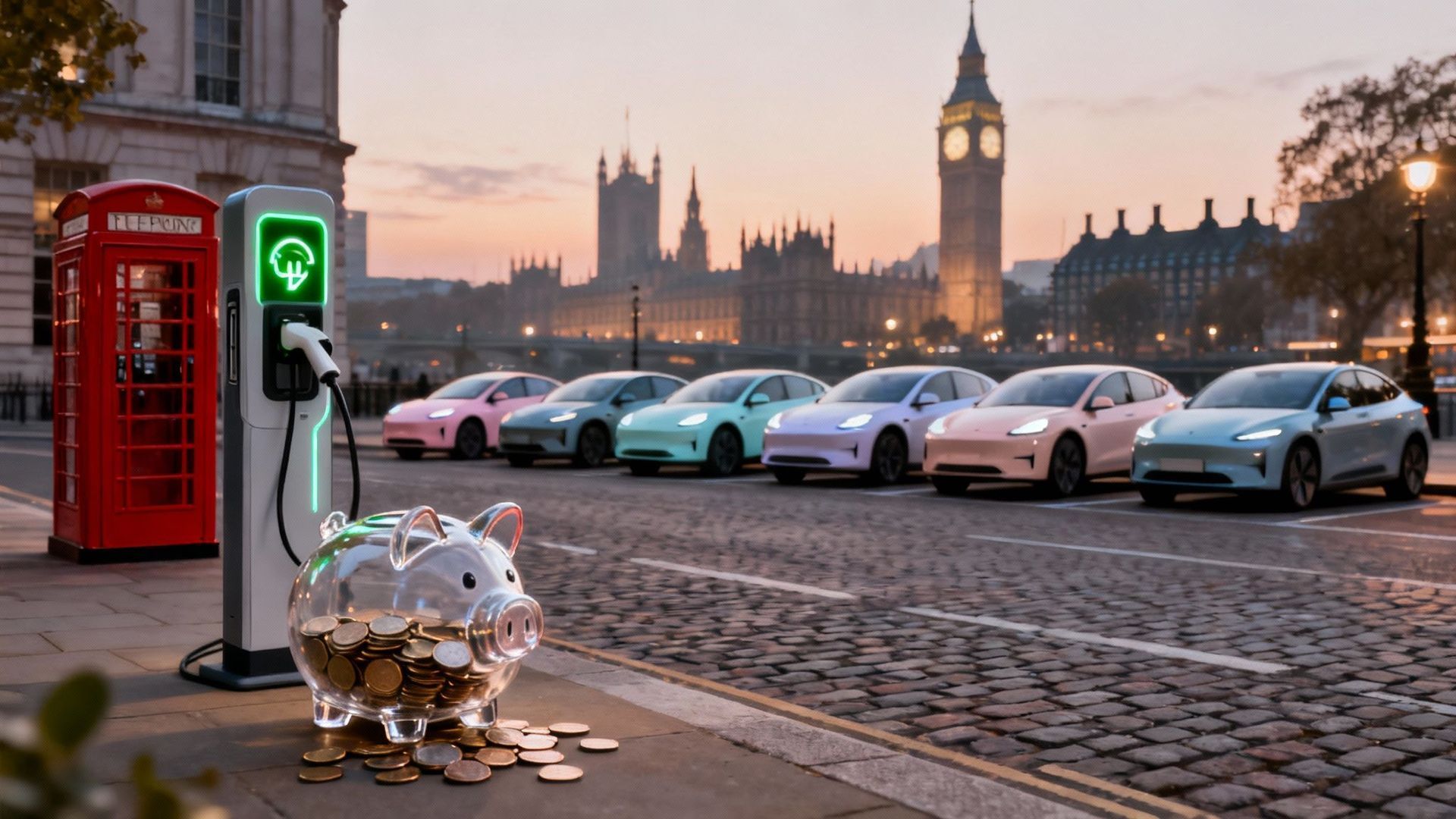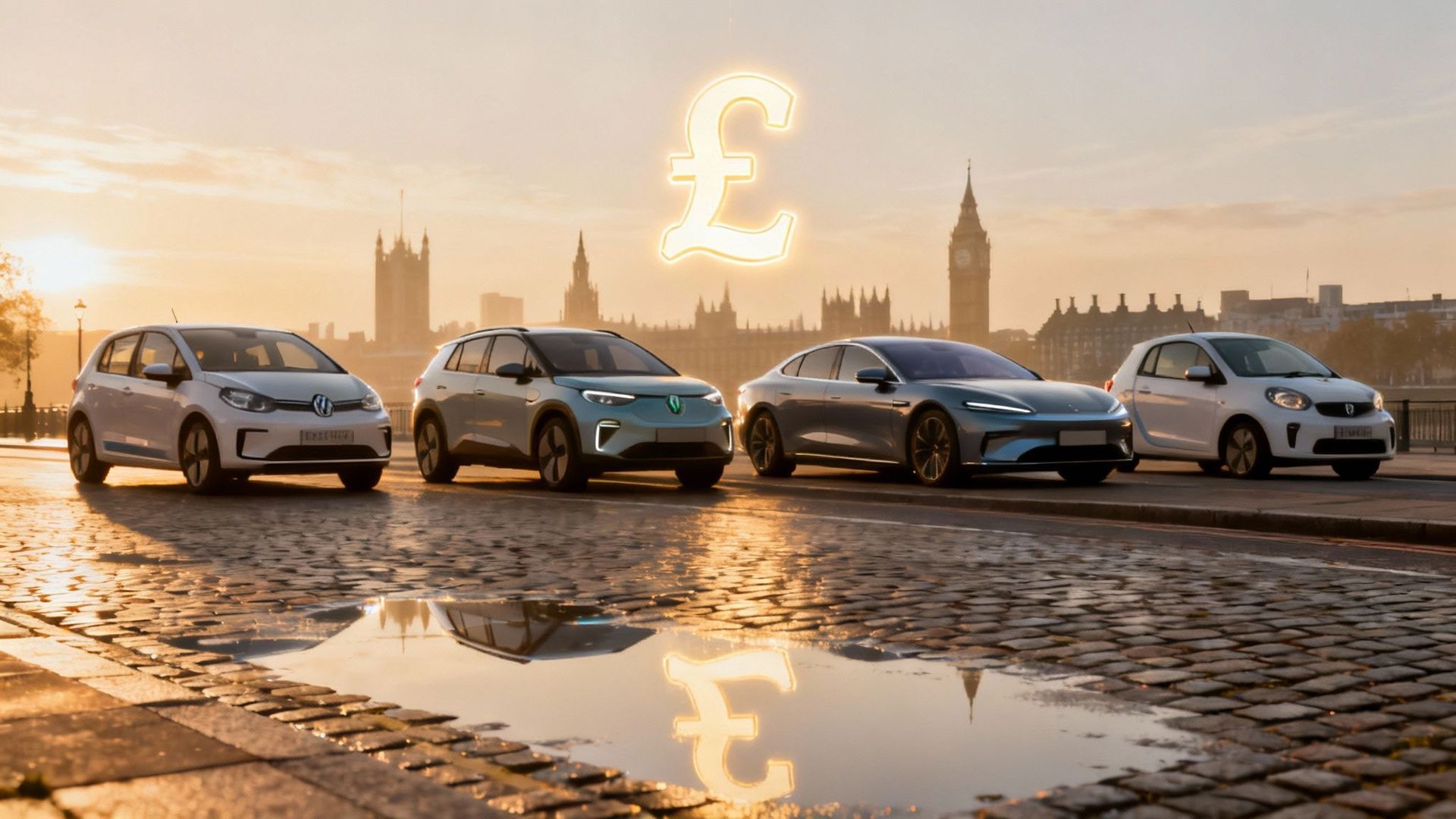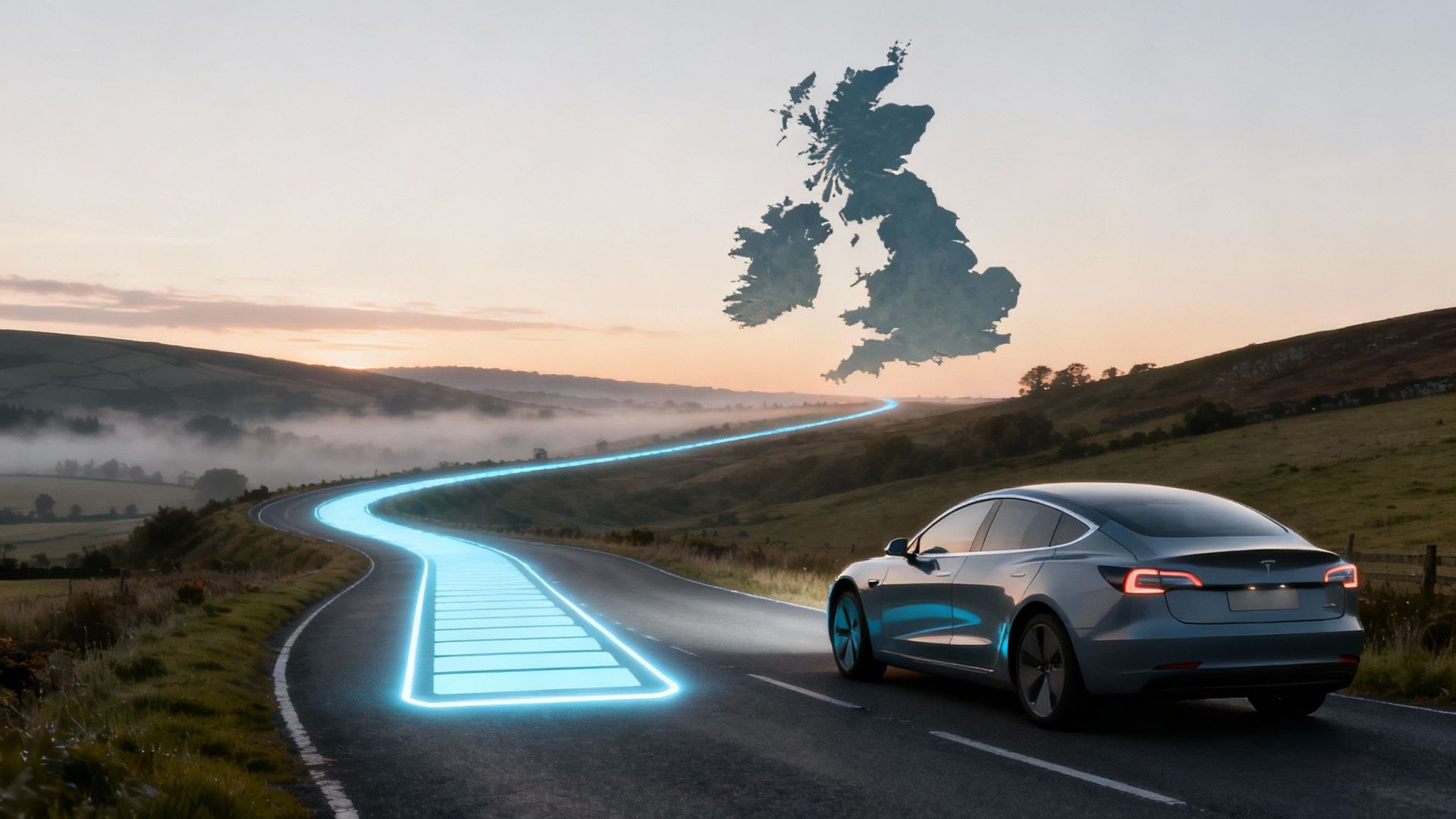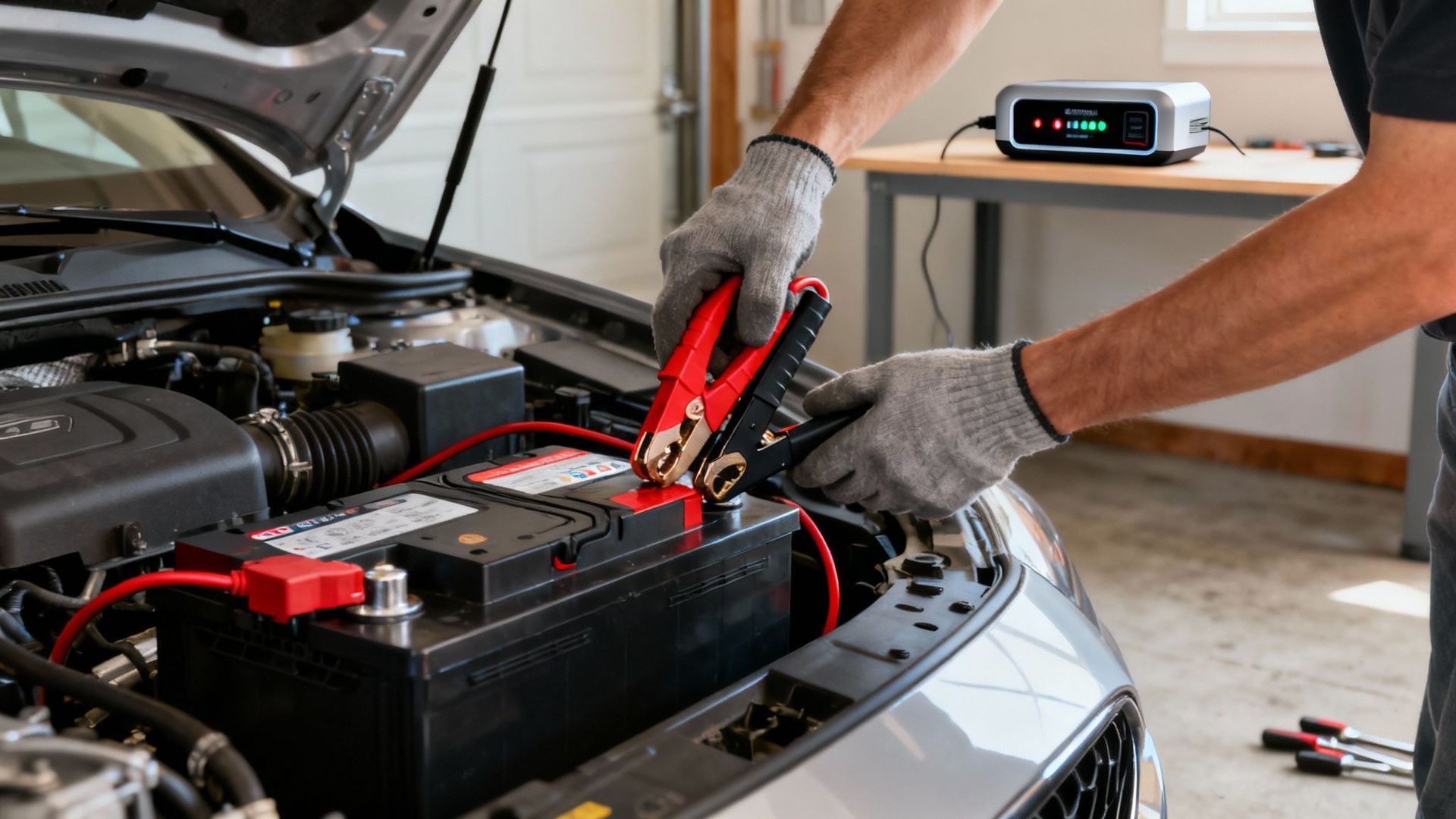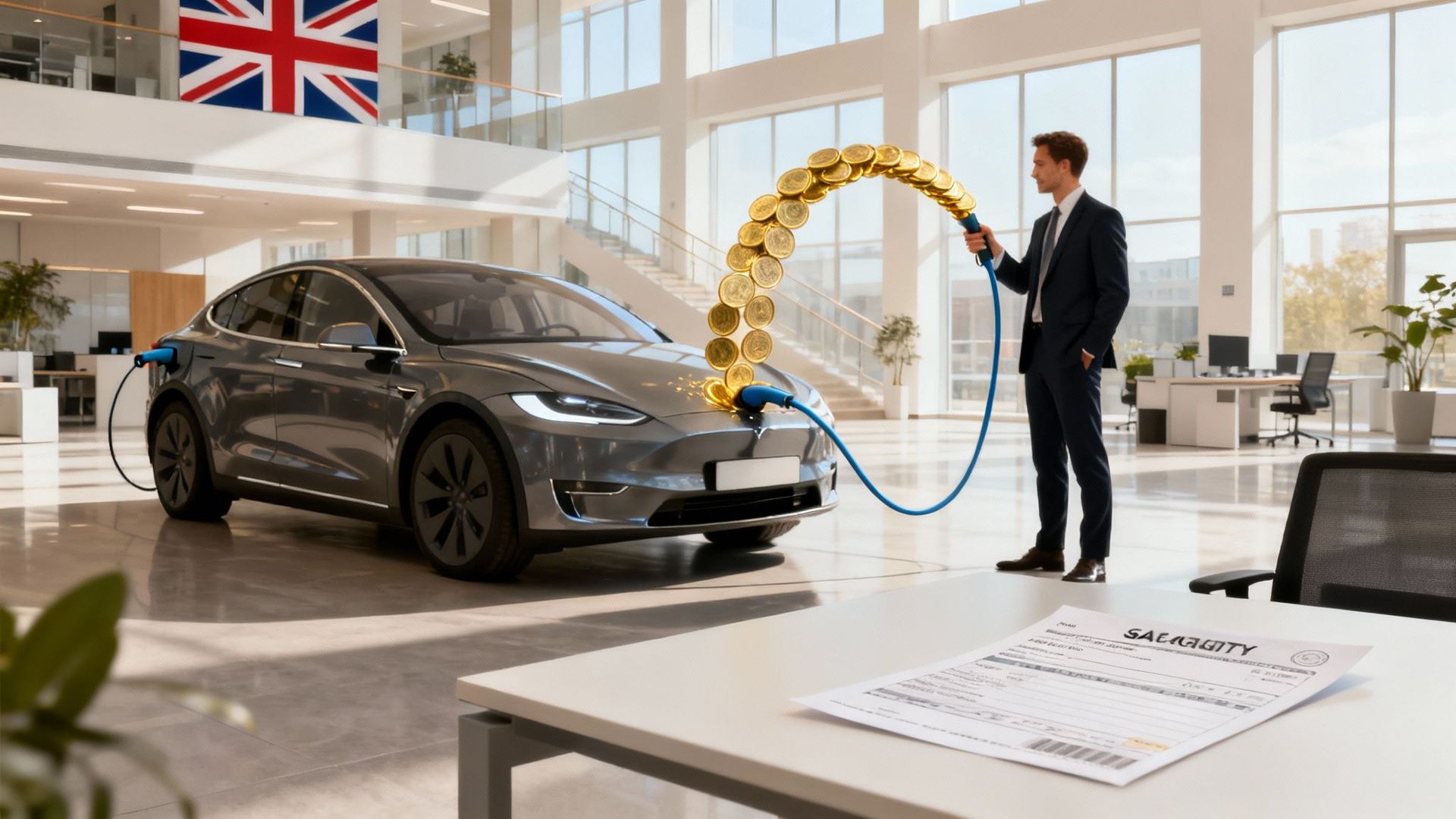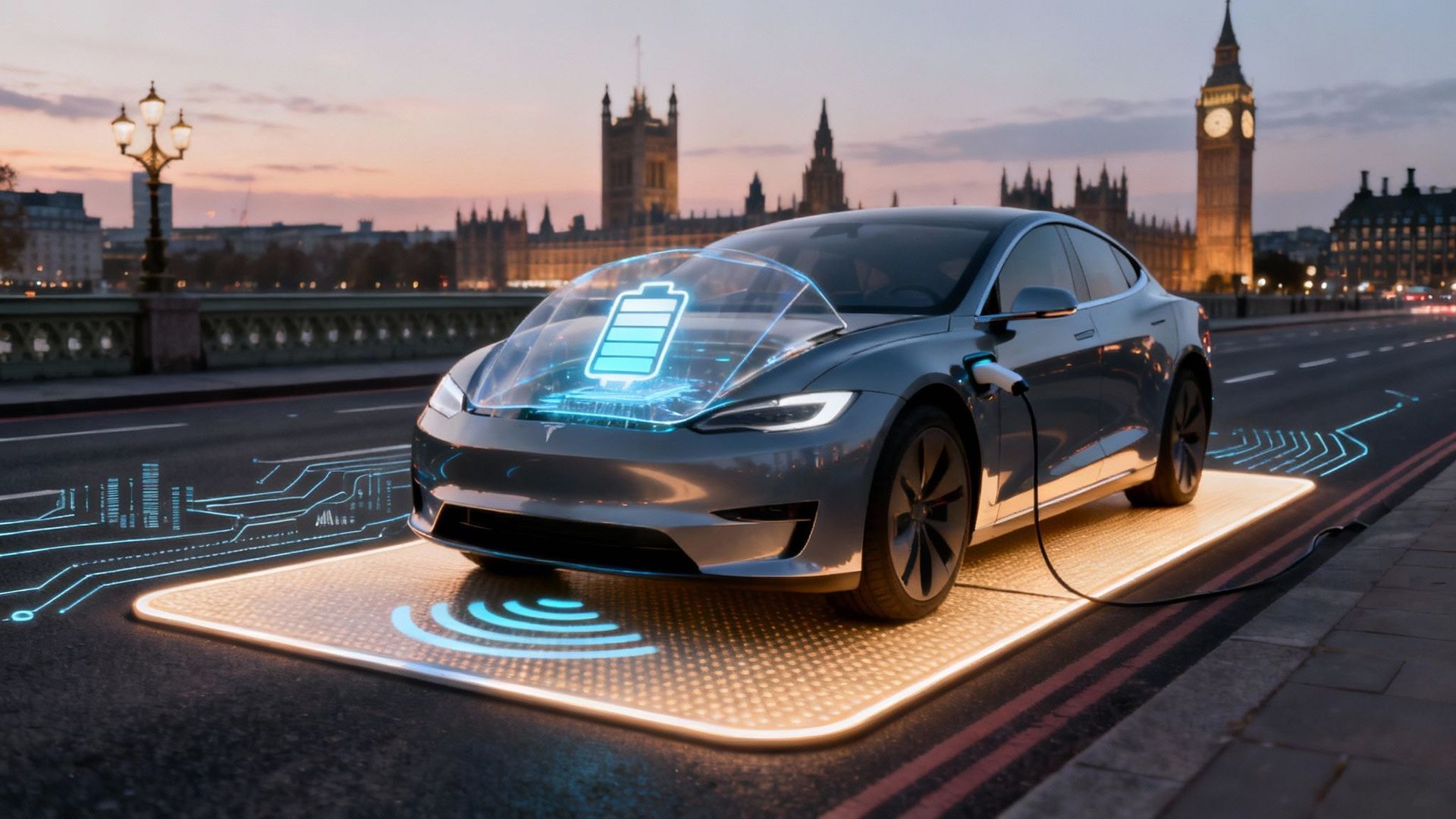Electric Car Comparison UK: Finding an EV That Won't Drive You Potty
Picking an electric car in the UK feels less like a purchase and more like trying to solve a Rubik's Cube while blindfolded. You're ambushed by acronyms like kWh and WLTP, not to mention the endless, mind-numbing debates about charging speeds. Our electric car comparison for UK drivers is here to slice through the nonsense. We're focusing on what actually matters on our crumbling British roads—from navigating a rammed motorway service station to tackling a pockmarked B-road on a grim, rainy Tuesday.
Navigating The UK Electric Car Maze
Let's be honest, the world of electric cars is a complete minefield. Manufacturers love to brag about astronomical range figures, probably achieved by a waif-like driver in a wind tunnel on a perfect summer's day in California. The reality of a freezing January morning on the M6 is, shall we say, a tad different.
This guide is your much-needed dose of reality. We couldn't care less about the biggest touchscreen or the daftest gimmicks. Instead, we're drilling down into the practical bits that decide whether an EV will be a dream or a daily source of rage for a UK driver. Think of us as your brutally honest mate who's already made all the mistakes and isn't afraid to tell you about them.
Ditching Ideal Conditions For British Reality
To compare these cars fairly, we must begin with a healthy dollop of British scepticism. The official WLTP (Worldwide Harmonised Light Vehicle Test Procedure) range is a useful starting point, but it's notoriously optimistic. You have to treat it as a "best-case scenario" number, dreamed up in a lab.
In the real world, a heavy right foot, whacking the heating up on a cold day, and even a bit of classic British drizzle will mercilessly chip away at that official figure. Expecting to get the advertised range every time is like expecting sunshine for a bank holiday weekend—a lovely thought, but you'd be a mug to bet on it.
The infographic below shows just how massive the gap can be between the advertised range and what you might actually get when the temperature plummets.
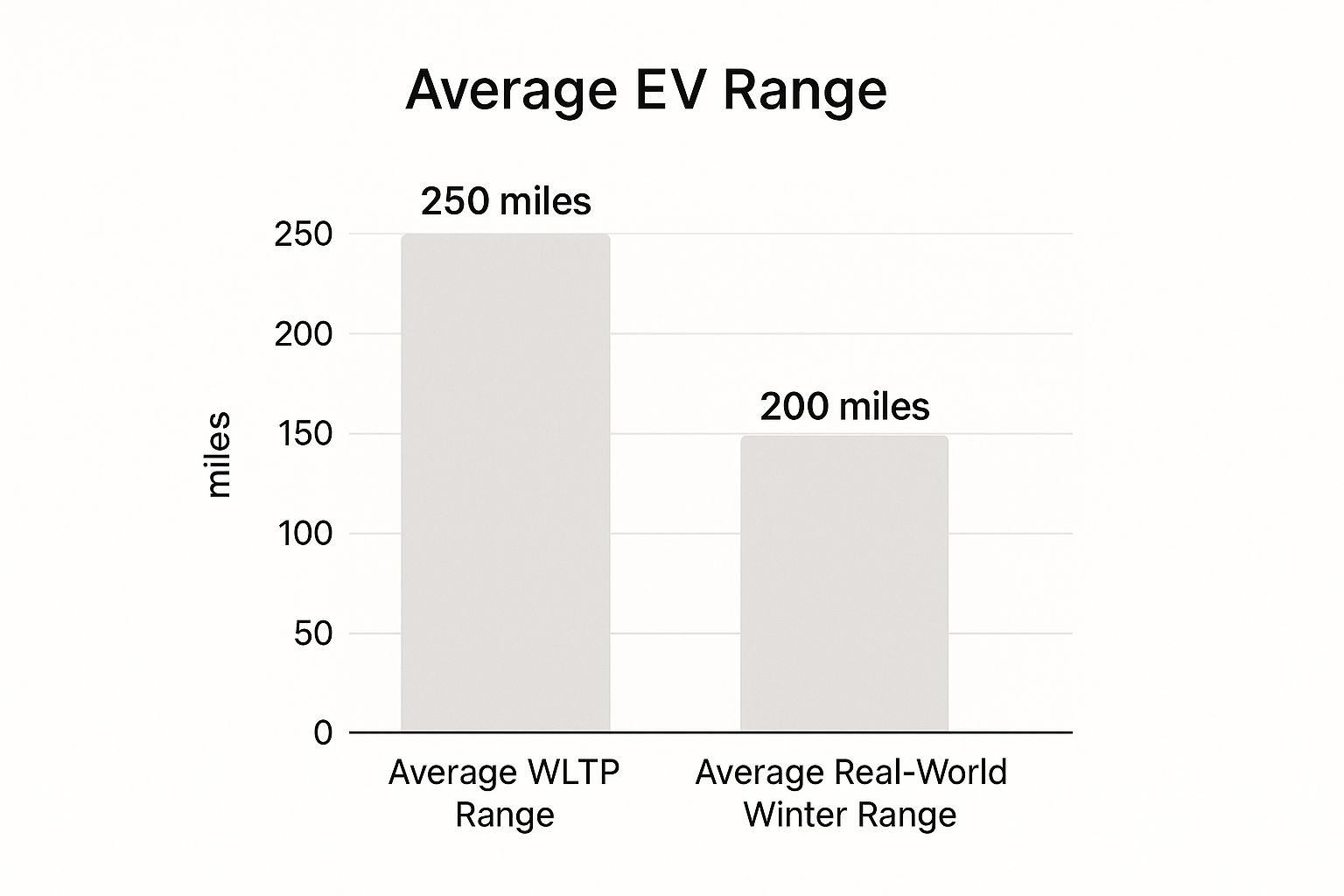
That typical 20% drop in winter is precisely why we focus on real-world performance over brochure guff. The stampede away from petrol and diesel is happening fast; EV sales shot up by an impressive 39.1% in June alone, while petrol car registrations actually dropped. Discover more about this EV market shift.
Of course, range is only half the battle. Then you have to contend with the public charging network. The current state of the EV charging landscape in the UK is a whole other adventure, filled with broken chargers, baffling apps, and queues that make Alton Towers look efficient.
Right, with that reality check out of the way, let’s get to know the cars up for inspection.
Meet the Contenders for the UK's EV Crown
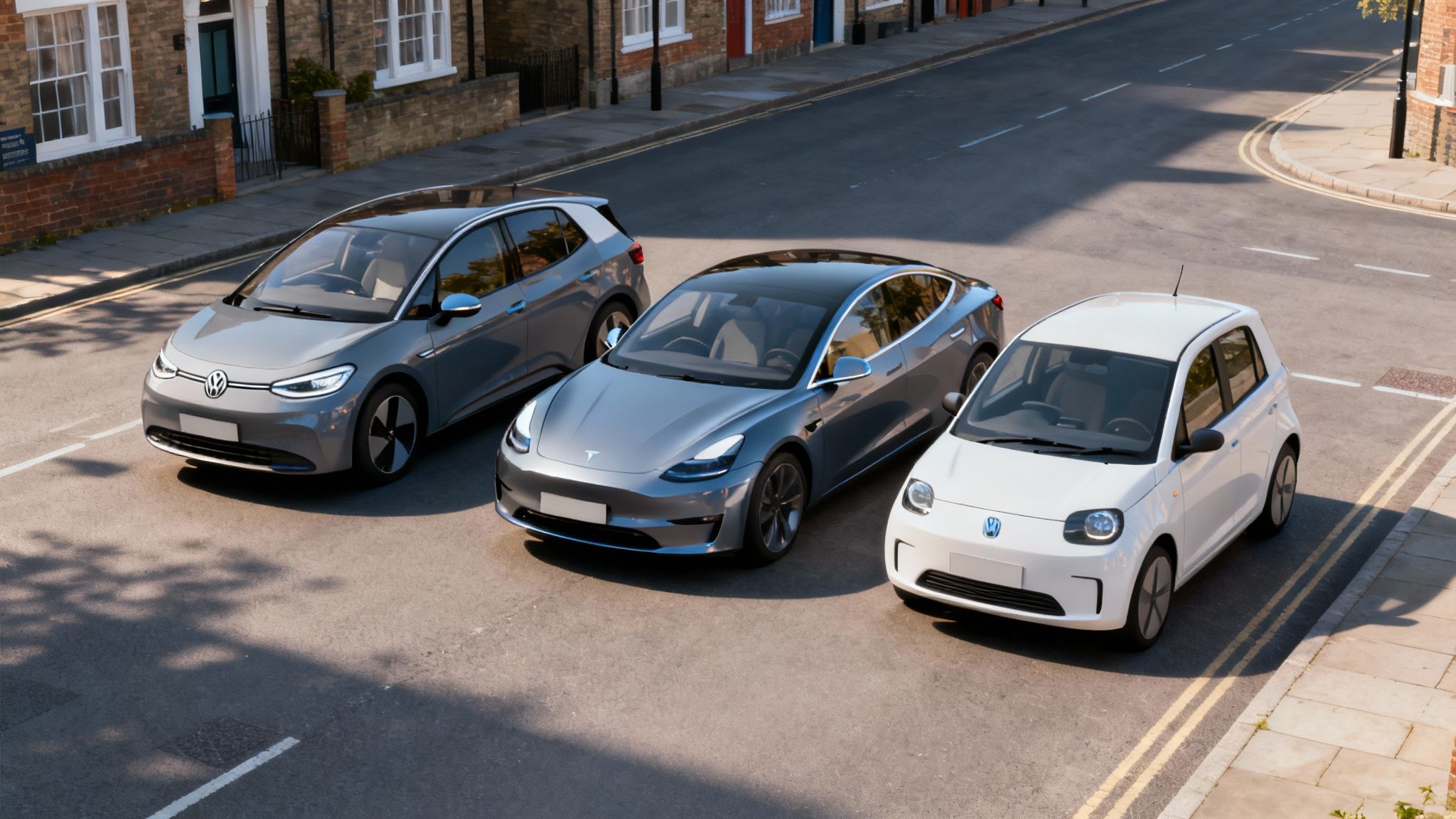
Alright, let's get down to brass tacks and introduce the main players in our UK electric car showdown. This isn't just a list of cars; it's a look at the different philosophies and characters battling for your attention, your cash, and that prized spot on your driveway.
First up, you have the established front-runners. Tesla, for instance, still feels like the smug tech bro of the car world—blisteringly quick, stuffed with gadgets, and propped up by its own superb charging network. It’s been the benchmark for yonks, but the big question now is whether the competition has finally caught up.
Then we have the German heavyweights—your Audis, BMWs, and Volkswagens. Think of them as the EV world's equivalent of a perfectly engineered, slightly boring Swiss watch. They deliver exceptional build quality, refined driving dynamics, and a premium feel without shouting about it. They favour solid engineering over flashy gimmicks.
The Upstarts and the Underdogs
Making a serious splash, especially when it comes to value, is MG. The once-quintessentially British brand has been reborn as a budget-friendly powerhouse, offering a surprising amount of car for your coin. It's the smart choice for those who prioritise practicality and price, but does that come with compromises elsewhere? You bet it does.
This lineup is no longer a snooty members' club. The most interesting part of the EV market right now is the sheer cheek of the new challengers who are genuinely giving the legacy brands a proper fright. They're rocking up with competitive pricing, solid tech, and zero brand baggage.
Finally, you can't ignore the new arrivals who are making a massive impact. Brands like BYD (Build Your Dreams) aren't just tiptoeing into the market; they're here to kick the door down. Hailing from China, their cars are arriving in the UK well-equipped and priced aggressively to hoover up market share.
And it’s a strategy that’s clearly paying off. BYD experienced a colossal 880% sales surge here, establishing Britain as its most crucial market outside of China. This proves drivers are increasingly looking beyond the badge for real value. You can read more about this impressive growth in the UK EV market.
UK Electric Car Contenders at a Glance
Before we dive into the nitty-gritty, this table gives you a quick snapshot of our top contenders. It’s the perfect way to see how the headline figures stack up side-by-side, from price and range to boot space.
| Car Model | Starting Price (£) | Real-World Range (Est.) | 0-60 mph | Boot Space (Litres) |
|---|---|---|---|---|
| Tesla Model 3 | 39,990 | 272 miles | 5.8s | 594 |
| Polestar 2 | 44,950 | 280 miles | 7.0s | 405 |
| MG4 EV | 26,995 | 218 miles | 7.5s | 363 |
| Hyundai Ioniq 5 | 43,445 | 238 miles | 7.3s | 527 |
| BYD Seal | 45,695 | 295 miles | 5.9s | 400 |
As you can see, the numbers tell an interesting story from the off. The MG4's price is a real eye-opener, while the Tesla Model 3 offers impressive boot space for a saloon. Now, let's get into the specifics of what makes each of these cars tick.
The Great British Range Test: Real-World Performance
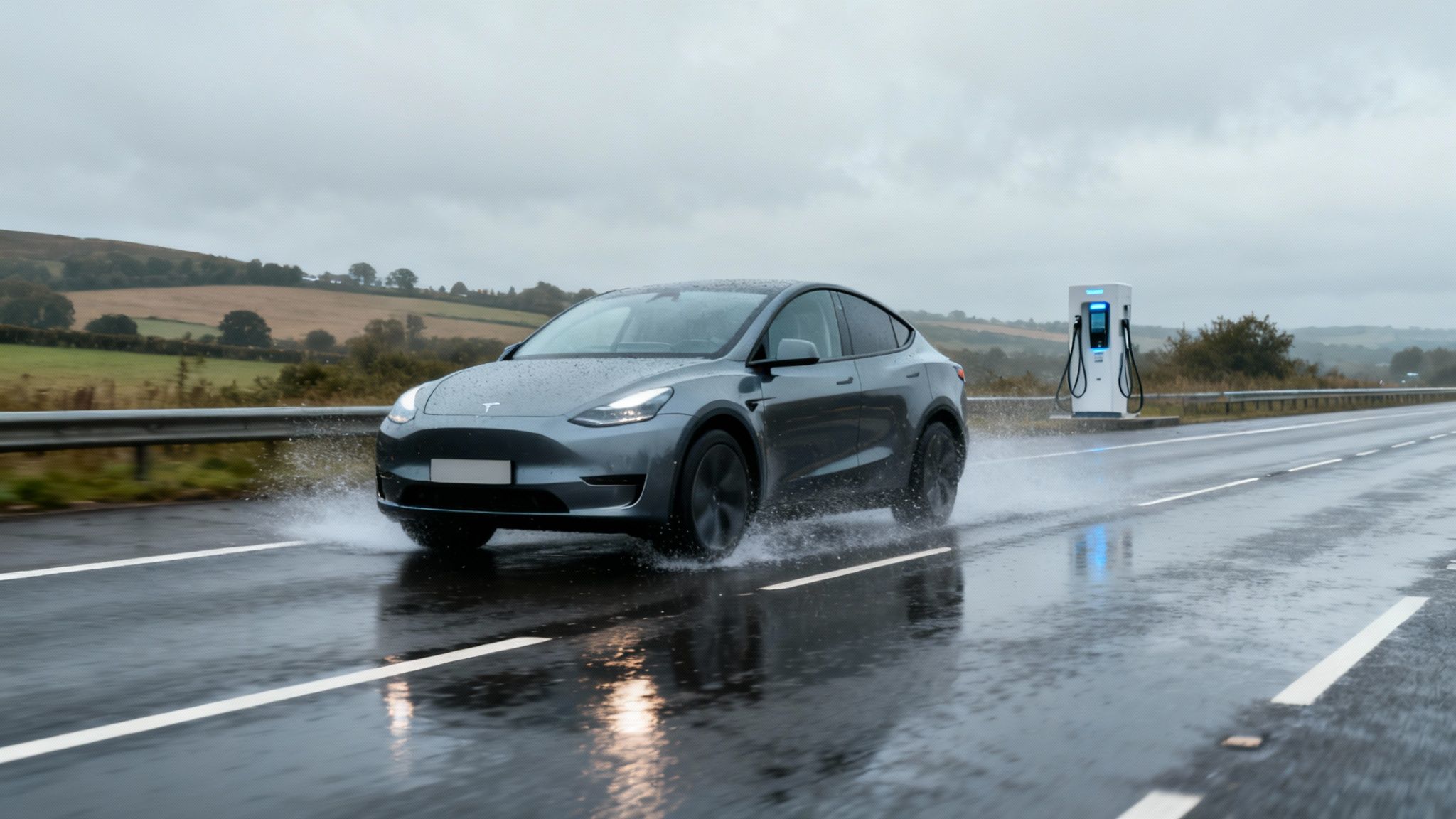
Right, let’s get to the juicy bit. The manufacturer’s official range figures are about as reliable as a politician's promise. We’re here to talk about what actually happens on the road—the kind of performance you get on a cold, damp Tuesday in Stoke with the wipers on full pelt and the heating cranked up to 'volcano'.
Forget the perfect conditions of a test track. Our electric car comparison for UK drivers focuses on two very British scenarios: the soul-crushing 'M25 Motorway Crawl' and the much more pleasant 'Peak District Country Jaunt'. This is where brochure fantasies meet tarmac reality.
The M25 Motorway Crawl
Cruising at a steady 70 mph (or, more realistically, crawling through stop-start misery) is a massive drain on an EV's battery. There’s no regenerative braking to trickle charge back into the system, just the motor constantly fighting against air resistance.
In these conditions, the premium models with their slinky aerodynamics and chunky batteries naturally pull ahead. The BYD Seal and Polestar 2 are particularly impressive here, holding onto their charge brilliantly and giving you a range estimate you can actually trust.
Some of the more budget-friendly cars, on the other hand, can feel a bit nervy on the motorway. Their range calculators often seem to have a panic attack, shedding miles faster than a Tory MP changes their mind. You quickly learn which cars you can depend on and which ones will have you sweating as you hunt for the next service station.
The Peak District Country Jaunt
This is where things get really interesting. A-roads and B-roads, with all their braking and accelerating, are the perfect playground for energy recuperation. A car that felt a bit breathless on the motorway can suddenly become incredibly efficient when zipping around the countryside.
Here, the MG4 EV and Hyundai Ioniq 5 truly come into their own. Their regenerative braking systems are fantastic at clawing back miles, making them ideal companions for everything from the school run to a weekend adventure. It’s a great reminder that a smaller battery doesn't always mean less useful range.
The biggest shock for new EV owners is often winter performance. A drop to near-freezing temperatures can slash a car’s range by 20-30% before you’ve even switched the heated seats on. It’s the single most important factor that official figures fail to capture.
Some cars handle the cold far better than others, largely down to having clever thermal management systems like heat pumps. For a deeper dive into this, it's worth reading our full electric car range comparison for the UK and other lies.
Ultimately, real-world range isn’t just about battery size. It’s a complex dance between efficiency, aerodynamics, the weather, and your right foot. Some cars are brilliant all-rounders, while others are specialists that excel at specific types of journeys.
Living with an EV: The Everyday Reality for UK Drivers
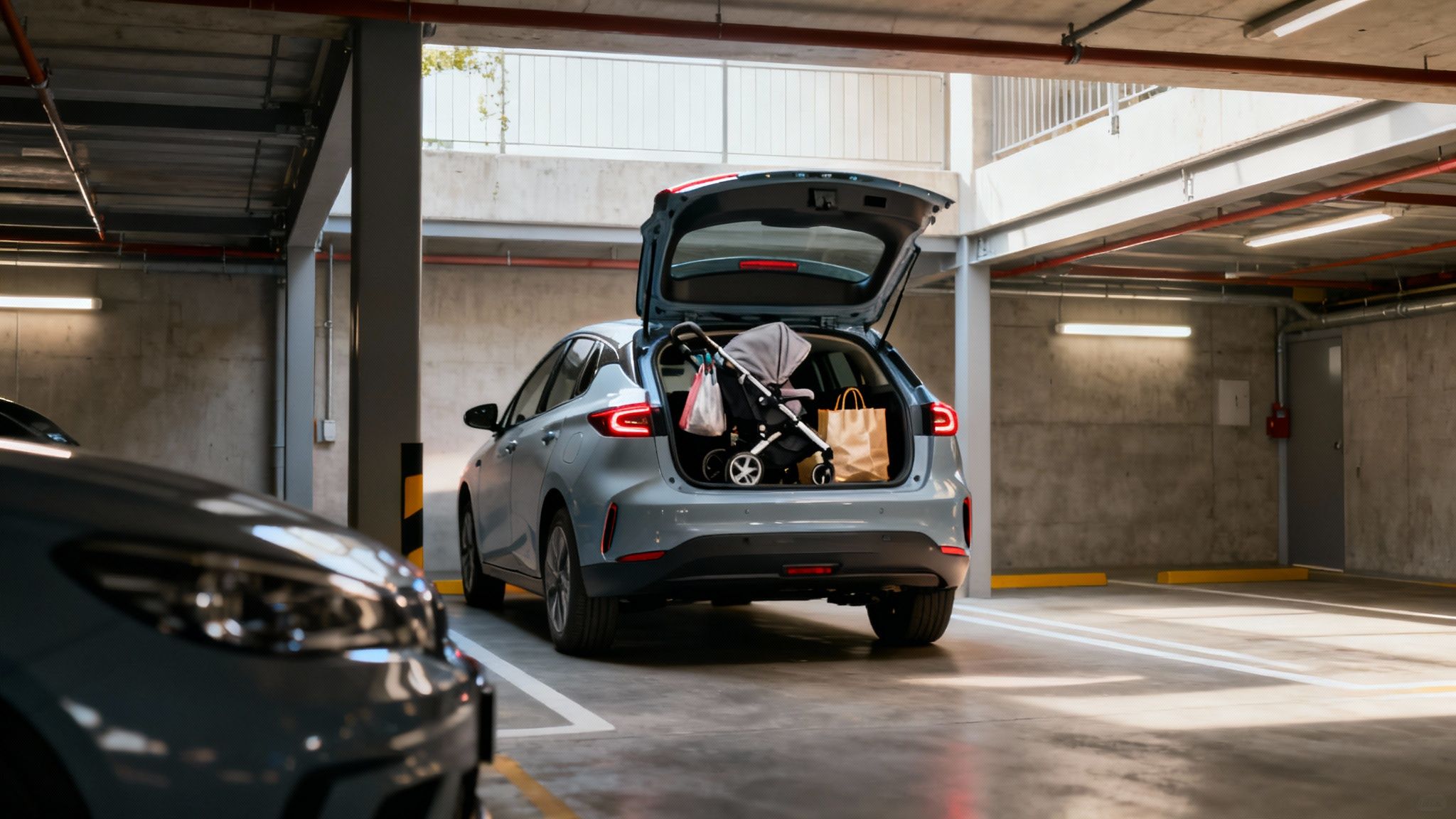
Headline range figures are great for pub bragging rights, but it's the day-to-day grind that really defines your relationship with an electric car. A huge battery is no good if the infotainment system drives you bonkers, or if parking it feels like mooring a ferry in a tight supermarket space. This is where we get into the nitty-gritty that matters for UK drivers.
We’re looking at the real-world challenges of British roads. Can you actually see out of the back when you're reversing into a narrow spot at the local Sainsbury's? Will the boot swallow the pram and the big weekly shop, or is it an either/or situation? Let's dive into the practical details the brochures conveniently gloss over.
The Infotainment Battle: Friend or Foe?
Your EV's central screen is its nerve centre, controlling everything from your route to the cabin temperature. When it’s rubbish, it’s a source of constant, simmering rage.
The Tesla Model 3 remains a leader here, with a system that's incredibly slick and responsive. The catch? Absolutely everything is controlled via that one screen, which isn't for everyone. In contrast, the Hyundai Ioniq 5 strikes a fantastic balance, blending a great touchscreen with actual physical buttons for core functions. It’s a godsend when all you want to do is crank up the heating without navigating through three different sub-menus.
Over in the Polestar 2 , you'll find a Google-based system, which is brilliant for its mapping and voice commands. That said, some of the earlier models had a reputation for being a bit buggy. The MG4 EV has a system that gets the job done, but it feels less polished than the others – a fair trade-off, really, given its tempting price tag.
Build Quality and Practicality
This is often where the premium price tags start to make sense. Both the Polestar 2 and Ioniq 5 feel exceptionally well screwed together, with high-quality materials and a reassuring solidity that suggests they'll stand up to years of family abuse.
Tesla’s interior, on the other hand, is minimalist almost to a fault. It’s undeniably clean and modern, but some of the materials feel a bit less premium than you might expect for the price. The MG4, while solid, doesn't try to hide its budget-friendly nature on the inside, but it’s perfectly functional and feels built to last.
One of the most underrated aspects of daily driving has to be the turning circle. A car that can pull a U-turn on a sixpence is an absolute gem in a multi-storey car park. One that needs the turning circle of an oil tanker will quickly become the bane of your life.
Here’s a quick rundown of how our contenders fare on those crucial, often-overlooked practical points:
- Visibility: The Ioniq 5’s large windows give you a great all-round view. The Polestar 2’s sleek, tiny rear window, however, makes reversing more reliant on the camera than your own eyes.
- Turning Circle: The MG4 is surprisingly nimble, making it a champion of tight city streets and cramped car parks.
- Boot Space: For sheer luggage capacity, the Tesla Model 3 comes out on top, thanks to a massive boot and a very handy ‘frunk’ (front boot). The MG4’s boot is a decent size but noticeably smaller than the Tesla's.
Finally, a quick word on charging. A car's maximum charging speed is only half the story. The Hyundai Ioniq 5 , with its sophisticated 800-volt system, can genuinely go from 10% to 80% in about 18 minutes at a powerful enough rapid charger. That's just long enough to grab a questionable service station coffee before you’re back on the road.
Calculating the True Cost of EV Ownership
Right, let’s talk brass tacks. It's easy to get carried away by the fuel savings when you switch to electric, but the showroom price is just the first page of a much longer, and often more painful, financial story. Working out the genuine cost of running an electric car in the UK means navigating a world of insurance shocks, tax quirks, and the lottery of public charging costs.
The most obvious win is, of course, fuel. Ditching the petrol station for a plug in your garage is a game-changer. That said, the initial purchase price is still a major hurdle for many, even though the price gap between EVs and petrol cars is finally, mercifully, starting to shrink.
But the real devil is in the details. Take insurance, for example, which has become a proper headache for EV owners. Insurers often see the powerful batteries and sophisticated tech, panic a little, and whack up the premiums. It’s not unusual for an EV to sit in a much higher insurance group than its petrol-powered equivalent, which can take a big bite out of those fuel savings.
Beyond the Purchase Price
Then you have the cost of setting up at home. For any EV owner who values their sanity, a dedicated home charger is non-negotiable. This will usually set you back between £500 and £1,000 . It’s a brilliant investment that unlocks cheap overnight electricity tariffs, but it's another upfront cost you need to factor in.
Public charging is a different beast entirely. The convenience of a rapid top-up at a motorway service station comes with a hefty price tag—costs that can sometimes creep uncomfortably close to petrol on a per-mile basis if you're not careful. This is where your personal driving habits completely change the financial outcome.
A high-mileage commuter who can charge cheaply at home overnight will save a fortune. In contrast, a city-dweller relying solely on expensive public rapid chargers might find their running costs are disappointingly close to their old petrol car.
The momentum in the market is clear, though. As of August, battery electric cars command a solid 15.8% market share. At the same time, petrol's slice of the pie has dropped sharply to just 28.1% . It’s a clear signal of where things are headed, despite these financial hurdles. You can read the full research about this significant market shift towards EVs.
The Real-World Cost Breakdown
To put this into perspective, let's look at two typical UK drivers:
- The High-Mileage Commuter: This person drives 15,000 miles a year, mostly on motorways. They charge almost exclusively at home on a cheap overnight rate. For them, the fuel savings are enormous, and they'll likely pay off the higher purchase price in just a few years.
- The City-Based Weekender: This driver only covers about 5,000 miles a year on short urban trips. They rely heavily on public chargers. While their fuel bill is still lower, the high cost of public charging and lower mileage mean it will take much longer to see a return on their investment.
As you can see, there isn't a single answer to whether an EV will save you money. It all comes down to your lifestyle and how you use your car. For a much more detailed analysis, have a look at our guide on the real cost of owning an EV compared to petrol cars, where we break down all the numbers.
The Final Verdict: Which EV Should You Actually Buy?
Right, after all that number-crunching and real-world testing, it’s time to land the plane. Picking a single "best" electric car is a fool's errand because your perfect EV depends entirely on your life, your budget, and what you need it to do.
So, instead of a one-size-fits-all answer, here are our definitive recommendations for UK drivers based on real-world situations. This isn't just about spec sheets; it’s about finding the right tool for the job.
Our Top Picks for British Drivers
We’ve narrowed the field down to four distinct categories. Each recommendation is grounded in the practical realities we've discussed, from handling the weekly shop at Tesco to surviving a rainy commute up the M1.
-
Top Pick for Families: The Hyundai Ioniq 5
This one's a game-changer for family life. With its incredibly spacious and well-built interior, a solid real-world range, and ultra-fast charging that minimises service station meltdowns with impatient kids in the back, it’s a brilliant family wagon. The Ioniq 5 masterfully blends day-to-day practicality with a design that won't make you feel like you've simply bought a sensible box on wheels. -
The Commuter’s Champion: The BYD Seal
If your life involves racking up serious motorway miles, the Seal is a superb choice. It delivers an excellent real-world range, a seriously comfortable ride, and a premium-feeling cabin that makes sitting in traffic jams slightly less soul-destroying. It's proof that the new challengers on the block are a genuine threat to the established players. -
The Best Budget-Friendly EV: The MG4 EV
It's simply impossible to ignore the sheer value for money the MG4 offers. It’s genuinely fun to drive, practical enough for most daily needs, and costs thousands less than its direct rivals. For anyone looking to make the switch to electric without having to remortgage the house, this is the one to get.
Ultimately, the best electric car is the one that slots seamlessly into your routine, not just the one with the biggest numbers on paper. Think about your worst-case journey, not your best, and choose the car that handles it with the least amount of fuss.
- The One for Driving Enthusiasts: The Polestar 2
If you actually enjoy the act of driving, the Polestar 2 delivers in spades. It has a fantastic chassis, sharp, responsive handling, and a sense of solid, Scandinavian engineering that makes it feel special every time you get behind the wheel. This is an EV for people who still care about how a car feels on a twisty B-road.
Answering Your Top UK Electric Car Questions
Let's finish up by tackling some of the most common questions and worries we hear from drivers thinking about making the switch. No fluff, just straight answers to the things that might be holding you back.
Your EV Questions, Answered
First on the list: battery life. Are the cold, damp UK winters going to kill your car's battery? The short answer is no. Today's EV batteries are impressively durable. Studies show they only lose about 1.8% of their capacity per year on average, so the battery will almost certainly outlive the car itself. It's actually prolonged extreme heat that does the most damage, and let's face it, we don't get much of that here.
What about finding a working public charger? It’s a valid concern. While the network is growing incredibly fast, you'll still run into the occasional broken or occupied unit. It's more of a minor annoyance than a deal-breaker, particularly if you have the ability to charge up at home overnight.
Thinking of towing a caravan? You absolutely can, but you need to be realistic about range. Expect it to plummet, often by 40-50% . A weekend trip isn't a problem, but a long haul down to the coast will require some careful planning around charge stops.
And finally, what about those government grants? The grant for buying a new electric car is gone for most of us now. However, you can still get financial help with installing a home charger. The biggest savings these days are found through company car schemes, where the tax benefits make leasing an EV far, far cheaper than a petrol or diesel equivalent.
Ready to dive deeper into the world of electric cars with reviews that tell it like it is? Explore VoltsMonster for more brutally honest guides, news, and comparisons. Visit us at https://www.voltsmonster.com to join the community.

